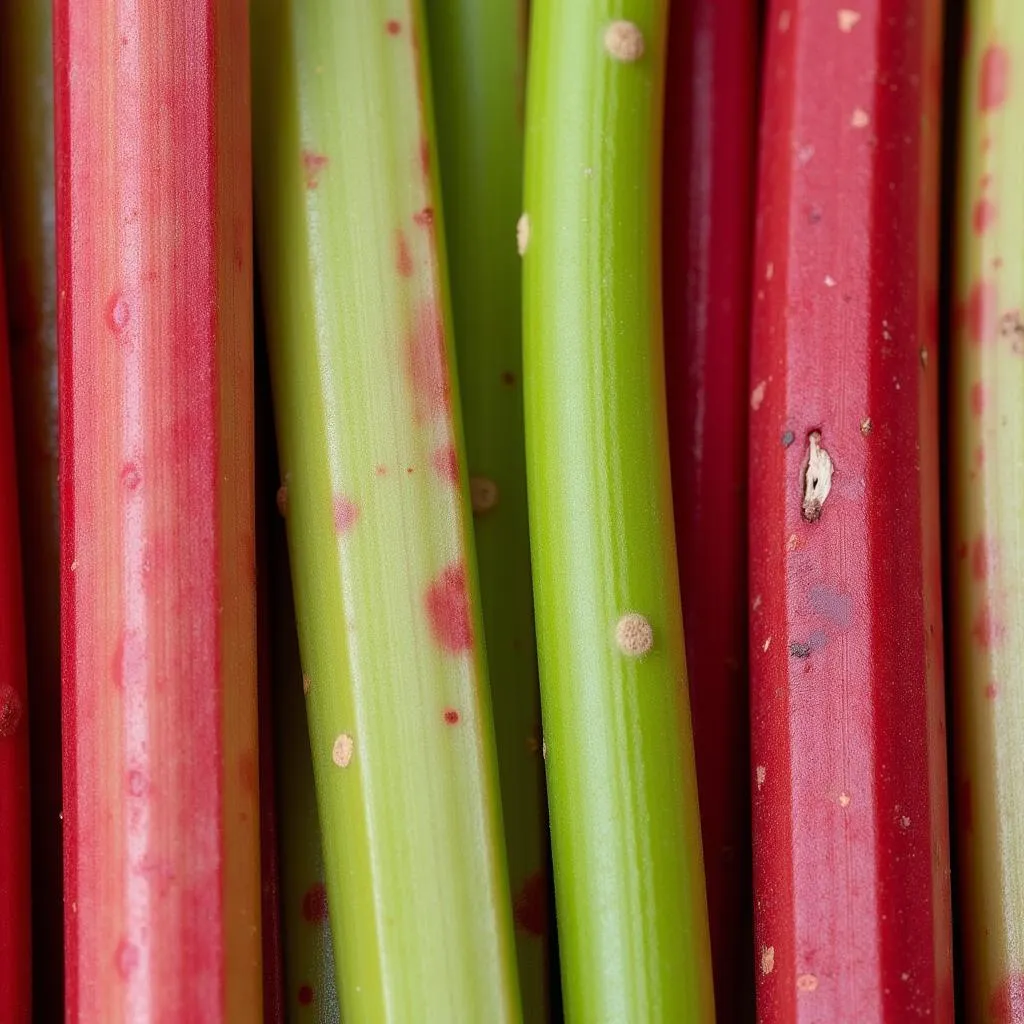Rhubarb, the crimson stalks often mistaken for fruit, possess a color as intriguing as their flavor. While often associated with reddish hues, the answer to “what color is rhubarb” isn’t as simple as it seems. Rhubarb’s color palette is surprisingly diverse, influenced by variety, growing conditions, and even the way it’s prepared. Join us as we delve into the fascinating world of rhubarb and explore the spectrum of colors it adorns.
Decoding Rhubarb’s Color Palette
From vibrant crimson to pale green, rhubarb showcases a surprising range of colors. Let’s break down the most common shades and what contributes to their unique appearances:
1. Rosy Red Rhubarb:
This is the color most commonly associated with rhubarb. Varieties like ‘Victoria’ and ‘Crimson Red’ boast these stunning deep red stalks, sometimes with hints of pink. The vibrant hue is due to high concentrations of anthocyanins, natural pigments responsible for the red, purple, and blue shades found in many fruits and vegetables.
2. Green Rhubarb:
Contrary to popular belief, green rhubarb isn’t unripe. Varieties like ‘Riverside Giant’ and ‘German Wine’ are naturally green, even when fully mature. While they contain anthocyanins, their levels are significantly lower than red varieties. Instead, chlorophyll, the pigment responsible for the green color in plants, dominates, resulting in their verdant hue.
3. Pink Rhubarb:
Pink rhubarb varieties, such as ‘Strawberry’, offer a delicate and visually appealing shade. Their color stems from a balanced presence of both anthocyanins and chlorophyll, creating a beautiful blend of red and green.
4. Speckled Rhubarb:
Some rhubarb varieties exhibit a speckled appearance, with streaks of red and green intermingling on their stalks. This unique pattern occurs due to the uneven distribution of anthocyanins within the plant tissue.
 Rhubarb Color Variations
Rhubarb Color Variations
Factors Influencing Rhubarb’s Color
Besides genetics, several factors influence the color of rhubarb:
- Sunlight Exposure: More sunlight generally leads to higher anthocyanin production, resulting in redder stalks.
- Soil pH: Acidic soil tends to enhance red pigmentation, while alkaline soil may favor green hues.
- Temperature: Cooler temperatures during the growing season can intensify red coloration.
- Variety: As mentioned earlier, different rhubarb varieties have varying levels of anthocyanins, influencing their natural color.
Rhubarb’s Color Transformation in the Kitchen
Interestingly, rhubarb’s color can change during cooking. The intensity of the red hue can deepen or fade depending on the cooking method and ingredients used. For instance, adding acidic ingredients like lemon juice can help preserve the vibrant red color.
Beyond the Stalks: The Color of Rhubarb Leaves
While we primarily consume the stalks, it’s crucial to remember that rhubarb leaves are toxic due to high levels of oxalic acid. They exhibit a deep green color, sometimes with reddish veins, but should never be eaten.
Rhubarb: A Colorful Addition to Your Culinary Creations
Whether it’s rosy red, vibrant green, or a delicate pink, rhubarb adds a burst of color and a unique tartness to your culinary creations. From pies and crumbles to jams and sauces, this versatile vegetable (yes, it’s botanically a vegetable!) can brighten up your dishes and tantalize your taste buds.
FAQs about Rhubarb and its Color
1. Does the color of rhubarb affect its taste?
While red rhubarb is often perceived as sweeter, the difference in taste between red and green varieties is minimal. The tartness, however, can vary depending on the variety and ripeness.
2. Can I eat green rhubarb?
Absolutely! Green rhubarb is just as edible and delicious as red rhubarb. It’s simply a different variety with a higher chlorophyll content.
3. Why does my rhubarb sauce turn brown?
Overcooking rhubarb can cause it to break down and lose its vibrant color, resulting in a browner hue. To preserve the color, cook it for a shorter duration or add acidic ingredients like lemon juice.
Explore More Culinary Colors
Curious about the hues of other ingredients? Delve into our articles on “what is april color” and “does the color of urine change when pregnant” for more fascinating insights.
Need Help Choosing the Perfect Colors?
Color Box Hanoi is here to assist you with all your color needs. Contact us at 0373298888, email us at [email protected], or visit our store at 86 Cầu Giấy, Hà Nội. Our team of color experts is available 24/7 to provide personalized guidance and help you create a space that reflects your unique style and preferences.

